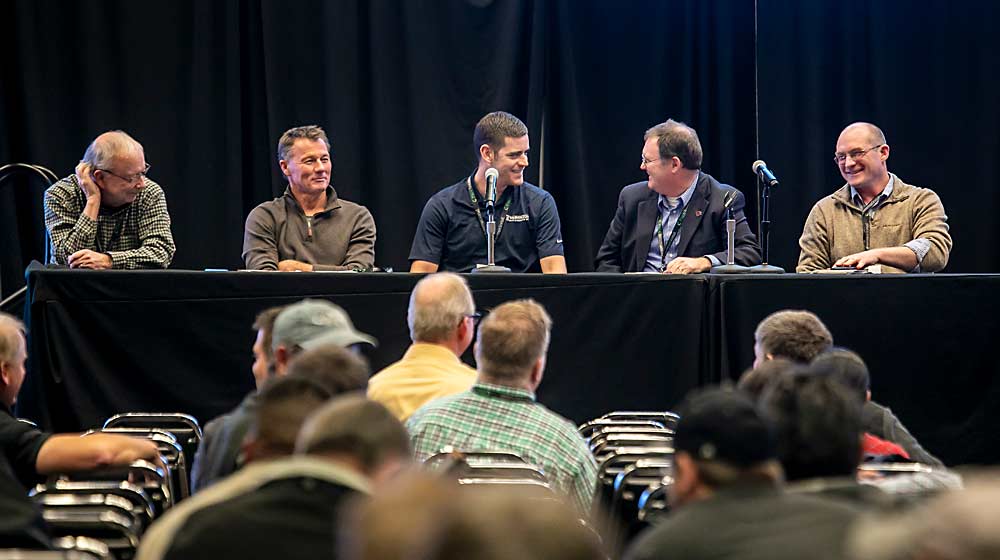
Months of hard work to nurture orchards and grow the best apples possible culminate in just a few days or weeks of harvest, and how you handle that harvest can make a big difference on the quality of fruit heading into storage — and your returns when it comes out.
At the Washington State Tree Fruit Association’s annual meeting in December, a panel of growers offered tips for protecting fruit quality during harvest and how to face facts when the season doesn’t go as planned.
A robust fungicide program, preharvest, prevents spots and rots postharvest, said Jason Matson of Matson Fruit Co. in Yakima, Washington, but it’s important to plan a rotation that has good balance with postharvest products to prevent overuse of any one chemistry.
“We need more product options,” he said. “And I’d like to see viable tools for organic production.”
When it comes to organic apples, the only option for preventing storage rots is to not let them get wet in the first place, said Paul Stiekema of Douglas Fruit in Pasco, Washington.
When it comes to using plant growth regulators such as Harvista and ReTain to manage harvest timing, the application timing itself is critical, Matson said. His team constantly checks for starch movement as harvest approaches, he said, because it only pays off if the timing is right.
As is often the case when it comes to fruit quality concerns, Honeycrisp came up frequently in the discussion.
“Honeycrisp is probably the most difficult apple to manage through harvest because it has such a wide range” of maturity, said Bruce Allen of Columbia Reach Pack in Yakima. “The best indicator is: What does the fruit taste like?”
It’s critical to pick the fruit at the proper maturity, not too early or too late, he said, even though multiple passes result in higher labor expenses.
“It takes three weeks to pick Honeycrisp,” he said. “If you are doing it in two weeks you are screwing up.”
To prevent bruising during transport and storage, leaving some headspace on the bins can help late-picked Honeycrisp, said Stiekema, but it’s not necessary on high-quality fruit.
As for protecting Honeycrisp from puncture wounds by stem clipping, opinions varied. Allen said that stem clipping can slow the pace of harvest and, for him, it’s more important to get the fruit picked at the perfect time than get all the stems clipped.
But Jake Gutzwiler, quality control manager for Stemilt Growers in Wenatchee, Washington, said it’s still important. Growers may notice that clipping — or not — doesn’t seem to have a big impact on packouts, but the stems actually cause the most damage during packing, he said.
That leads to problems on repacking or consumer rejects.
Broadly, the most important thing growers can do to achieve good packouts is be realistic about their fruit quality at the end of the season, Gutzwiler said.
“These guys have discussed all the painstaking things they do at the orchard level to create the perfect fruit. There’s months and months of excruciating work to create the great game plan for harvest,” he said.
“But, far too often, I see where growers take so much pride in the product we’ve grown that we have a hard time adjusting our game plan.”
It’s better to acknowledge upfront that fruit isn’t going to make it through a 10-month storage season in top shape than to push for it anyway and face disappointing packouts.
“I plan to pick optimal quality fruit in terms of size and color and maturity to catch that window for long-term storage, but if something goes wrong along the way and I have to wait to get more fruit size or it rains for seven days straight, then maturity has moved along and I can’t store that fruit for 10 or 12 months now,” Gutzwiler said. “But we have to live in reality.” •
—by Kate Prengaman






Leave A Comment